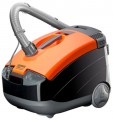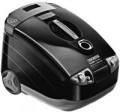Motor power
Rated power consumed by the vacuum cleaner. In models with power adjustment (see below), the maximum value is taken into account in this case. We are talking about the characteristics of the installed motor, which is the main, and in most vacuum cleaners, the only consumer of energy.
Higher power increases suction force and improves overall cleaning efficiency. In addition, a more powerful unit is easier to equip with a capacious dust collector. On the other hand, only vacuum cleaners of the same type with the same types of dust collectors can be directly compared by this parameter (see above for both). And even in such cases, the actual suction force (see below) may be different — and it is it that determines the real efficiency. However, the total power also allows you to generally evaluate the capabilities of the vacuum cleaner, including in comparison: a 1500 W model will significantly outperform its 800 W counterpart in efficiency (although it is impossible to say exactly by how much). But what definitely depends on this indicator is energy consumption.
As for specific power values, they are largely related to the type of device. For example, handheld models, robots and uproght units have low power —
less than 1500 W(and often noticeably less). Such values are quite popular among other types of vacuum cleaners (conventional, industrial, workshop, etc.), but among them there are already more solid indicators —
...f="/list/90/pr-1067/">1500 – 1750 W,
1750 – 2000 W and even
more than 2000 W.Dust collector capacity
The nominal volume of the dust collector installed in the vacuum cleaner.
This indicator largely depends on the type of unit (see above). For example, in most handheld household models, the capacity
does not exceed 0.5 L. The volume of the container in upright vacuum cleaners and robots can be somewhat larger — among the first variety there are quite a few models for
1 – 2 liters or even more, and among the second — by
0.6 – 1 liter and a little more. For conventional vacuum cleaners, the minimum figure is actually about 0.8 – 1 L; dust collectors for 1 – 2 L and
2 – 4 L are very popular in such devices; the maximum capacity is actually
4 – 6 liters — units of a similar layout, but with a larger capacity, are usually referred to as household ones. In turn, relatively small containers are occasionally found among workshop models. However, in vacuum cleaners of this type, the capacity is generally quite large — it can reach
26 – 50 liters or even
more ; the same applies to industrial (construction) units.
In general, a larger dust container allows you to work longer without interruptions. On the other hand, a capacious container itself takes up more space and, accordingly, affects the size, weight and price. So when choosing th
...is parameter, it is worth considering the actual features of the use of a vacuum cleaner. Here we can give such an example: for a full-scale cleaning of an average city apartment, a capacity of about 1 – 1.5 litres is required. Thus, say, a 4-litre bag allows you to carry out two such cleanings with sufficient efficiency without unloading the vacuum cleaner. There are more detailed recommendations regarding the optimal volume of the dust collector, including specific cleaning options. These recommendations can be found in special sources.Cord length
The length of the power cord that is equipped with a vacuum cleaner powered by an outlet.
Here we note that manufacturers select the specific length of the cord depending on the general purpose of the unit. In general, the length
of 4 – 5 m and
less can be called small,
5 – 6 m — medium,
6 – 7 m and
7 – 8 m — more than average, and in some models this figure is
more than 8 m. However, a lot depends on the specifics of the vacuum cleaner. For example, among conventional units there are many models with a 4-5 m wire (this is enough for cleaning on the scale of an apartment, a private house or a small office space), but for industrial solutions this is a very limited indicator.
Keep in mind that a longer power cord is not always more convenient. On the one hand, it provides more freedom when working. On the other hand, it can create inconvenience at a short distance from the outlet as well as during storage/transportation. In addition, you can use an extension cord to work away from the outlet. So when choosing, you need to take into account the specific needs of the use of a vacuum cleaner. Detailed recommendations for different situations can be found in special sources.

